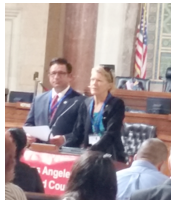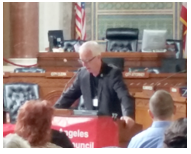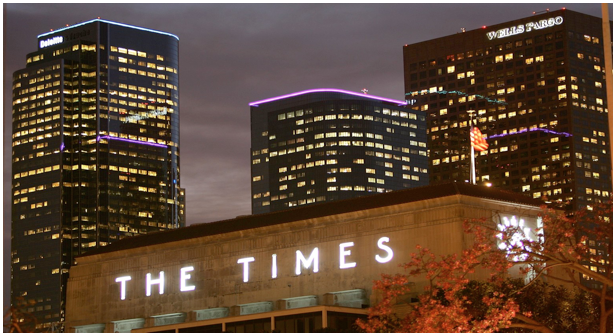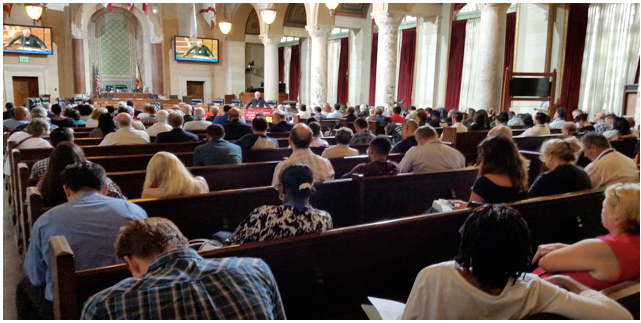NEIGHBORHOOD COUNCIL WATCH-Saturday morning July 30, Budget Day was indeed “on” at City Hall. Breakfast started at 7:30 a.m. as LA Neighborhood Council (NC) members co-mingled in the Art Deco style chambers. An hour later at the City Council chambers, a plenary session of speakers, namely City Officials and NC Budget Advocates shined the light on past and present city budget matters. In the second and final session NC Budget Representatives by regions elected new Budget Advocates for fiscal year 2016-17.
Empower-LA Administrator for Budget Day Mike Fong said that about 200 people registered electronically. At the event, Jay Handal counted about 200 attendees. “I did a head count while standing there,” he said.
 Liz Amsden, BA Co-Chair, opened the ceremony with, “…we provide role models in our communities and for our leaders, and see positive outcomes. That’s why we’re here today to learn a little more to be able to give our neighbors a hand, not to make money but to develop and nurture human capital.”
Liz Amsden, BA Co-Chair, opened the ceremony with, “…we provide role models in our communities and for our leaders, and see positive outcomes. That’s why we’re here today to learn a little more to be able to give our neighbors a hand, not to make money but to develop and nurture human capital.”
Then, BA Co-Chair Terrence Gomes reminded the NC members that the purpose of NCs is to be a conduit between our stakeholders and City Hall. Gomes said, “… for some of you in the valley, it’s a long way for your stakeholders to yell over here for us to hear, that’s why the neighborhood council system was started.”
Four years ago, the Budget Advocates started interviewing departments and saw ways of saving money for the city. Gomes elaborated, “We saw what needed to be done and saw a vision for the city. We wrote the White Papers, to give guidance to the City.”
General Manager of the Department of Neighborhood Empowerment (DONE), Grayce Liu, announced that this budget year her Department started with 26 employees to work with the 96 NCs. City has added 10 staffers with an additional four coming in from the Office of the City Clerk, she reported. On the field side, six new staffers will soon be hired and trained to attend NC meetings. Liu asked for a show of hands of first timers in the audience and 50% raised their hands. She welcomed them as she closed.
In succession, City Council President Herb Wesson introduced himself as the chair of the committee that oversees the NC system. He said, “We have accomplished a lot with you as my partners and equal participants. We have increased the budget by $5,000 for each NC, so you can deliver the services that your NC areas need.”
As a result of the partnership, Councilman Wesson assisted in putting in place a new policy: NC members can speak during public comment time at City Council and Committee Meetings for up to five minutes at the discretion of the presiding officer.
In addition, Wesson said that, as he visited NCs throughout the City, he met many members with concerns related to accounting issues, specifically, “not getting reimbursements in time or a lot of rules shifting and things of this nature.” In January, as a tentative solution, the accounting functions of DONE will be moved to the Office of the City Clerk. Wesson added, “It has expertise in making payments. I believe it will be better and if it doesn’t work we’ll change it again. Let’s don’t be afraid to fail. And if we do, we’ll fix it.”
Next, City Controller Ron Galperin briefly discussed the LA City Controller homepage that links to four distinct panels: ControlPanel LA, Utility/Panel LA, GeoPanel LA, and EconomyPanel LA. Galperin said that these tools are to be used to make government spending decisions that are data driven and wise.
“For example, the Economy Panel shows in what districts people are using the most public transportation; displays the income levels across the City per District; and includes which districts have the highest and lowest number of renters verses homeowners. Also a search is available for neighborhood council expenditures by NC name. “The more this tool is used, the more aspects you’ll find,” Galperin said.
Then, Chief Administrator Officer (CAO) Miguel Santana provided a detailed overview on how the City of Los Angeles manages its budget.
Santana said that the total budget for any department with a seal of the City is $25 million; this includes the LA Airport, LA Harbor, and LADWP. The total number of City employees is 48,000.
Santana oversees the City’s $8.7 billion budget, including:
- $5.5 Billion are discretionary, general funds with no restriction on how they can be spent
- $3.2 billion are nondiscretionary, special funds with specific purposes.
Some of the City Reserve Accounts coming out of the General Fund include these percentages: 2.5% for an emergency reserve; 5% covers two reserves contingency and emergency; 1.6% is set aside for capital improvements to repair sidewalks, streets, facilities, etc. Included is a rainy day fund for an emergency crisis. In addition, the city has “a one-time use fund that we use for one-time things,” Santana said. This is the second year this money category has been used, as in, for capital improvements, he said.
Most of the money from the Discretionary Fund (over 70%) goes for public safety to pay for Police and Fire Departments; 4.6% goes to libraries; 5.8% to recreation and parks; 8.5% for Street Services, Transportation, Engineering, Contract Administration, Capital Improvements, Building and Safety, and Planning; and, 3% for the City Attorney.
“Most of our revenue comes from property taxes; this is the most stable of all of our funding sources, it is the stability of the city,” Santana said. “Most of our sales tax does not come to the city; it goes to state and county.”
In prior years, the city “was banking overtime to police officers at time and a half” with collection at retirement. Santana said that the most responsible way to do it is to budget $90 million. “This is about the amount necessary to keep the public safety capacity at the existing level,” he said.
“It’s in the City Charter that at the end of the year the budget is balanced,” Santana said. “This year it is balanced.”
Budget Advocate Jay Handal has been working with homeless issues for 28 years. He opposes the $1 billion bond that will be on the ballot this November. It would provide funds to be spent over the next 10 years for the homeless.
Handal said that the city finds money to build brand new animal shelters for stray animals, yet “we walk over the homeless on the streets who have to defecate on the streets because they have no place to live and no place to shower.”
Presently there are 27, 000 homeless living on the streets of Los Angeles. “And that number will grow, not stay the same in the next 10 years,” Handal said.
Living on the streets exacerbates illness and leads to the use of a variety of public systems that taxpayers fund. This is very inefficient and costly. It's the responsibility of the government and not the taxpayers to provide money to create permanent supportive housing for the homeless.
 Jay Handal (left) opposes the $1 billion bond because there are too many unanswered questions, such as:
Jay Handal (left) opposes the $1 billion bond because there are too many unanswered questions, such as:
Where is the real plan written?
How many supportive units will fit in the seven proposed properties?
Over what period of time will these 10,000 units be built?
How many units per year? When will construction begin?
Who picks the developers? How would developers get their financing?
Who picks the nonprofits to run this type of project?
How much money will be used to persuade neighborhoods to accept these projects?
How much money will be spent when people oppose the projects?
Who will pick the community expediters to go out to negotiate for the construction of these buildings?
How much money will go for litigation costs for CEQA and EIRS when environmental issues arise?
Does the Planning Department have the personnel for these activities?
The next speaker was Councilman Paul Krekorian from CD 2 who is the Chair of the City Council Budget and Finance Committee.
Krekorian recounted how a former Mayor of Los Angeles once wrote an editorial for the Wall Street Journal, predicting it was inevitable that Los Angeles would be bankrupt within three years. Krekorian said, “In 2010 the challenge that we were facing was monumental, we couldn’t figure out where the bottom was.”
He specified that the City had projected a $1 billion deficit, with a general funds budget of 4.75 billion. “Since then, in the last two years, we’ve rebuilt our reserve funds by far more than we’ve ever had in history.”
Krekorian said allowing Budget Advocates to have a seat at the table for budget discussions with general managers and the mayor’s budget office has created a collaborative effort contributing to the process of recovery.
Krekorian noted that over the last three years, the City has appropriated $30 million a year for infrastructure costs, including the repair of city sidewalks to offer better mobility for our four million residents. He added, “We’ve cut unemployment in half. We hired 15,000 people in summer youth jobs this year so they can build a better future for themselves.”
Councilman Krekorian thanked the NC members for being engaged and staying involved. He said, “Government is an ongoing process that never stops.”
(Connie Acosta writes about Los Angeles neighborhood councils for CityWatch.) Edited for CityWatch by Linda Abrams.








 Liz Amsden, BA Co-Chair, opened the ceremony with, “…we provide role models in our communities and for our leaders, and see positive outcomes. That’s why we’re here today to learn a little more to be able to give our neighbors a hand, not to make money but to develop and nurture human capital.”
Liz Amsden, BA Co-Chair, opened the ceremony with, “…we provide role models in our communities and for our leaders, and see positive outcomes. That’s why we’re here today to learn a little more to be able to give our neighbors a hand, not to make money but to develop and nurture human capital.”  Jay Handal (left) opposes the $1 billion bond because there are too many unanswered questions, such as:
Jay Handal (left) opposes the $1 billion bond because there are too many unanswered questions, such as: 


